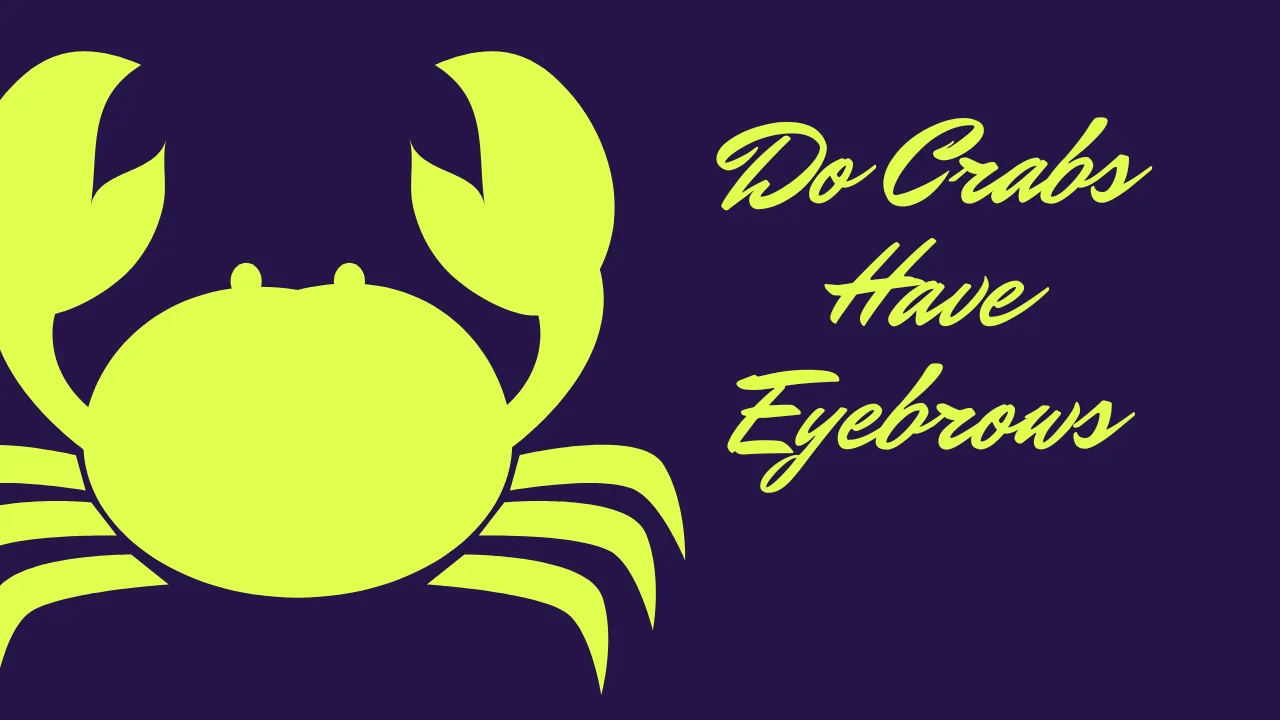Do Crabs Have Eyebrows? The Truth Behind Their Eye Anatomy
When observing the fascinating world of crabs, a peculiar question might arise: do crabs have eyebrows? It’s a question that sparks curiosity and even humor. The answer isn’t as straightforward as it may seem, largely because crabs are not mammals, and their anatomy is vastly different from ours. However, the structures near their eyes might make one pause and wonder. Let’s dive into this intriguing topic and explore what crabs possess instead of eyebrows, their functions, and why this question is more interesting than it appears at first glance.
Also Read: Rougamo Bread: Flaky, Flavorful, and Unforgettable
Do crabs have eyebrows
Crabs don’t have eyebrows like humans do, but some species of crabs have structures on their carapace (the hard shell covering their bodies) that might look like “eyebrows.” These are often ridges or projections near their eyes that help protect their eyes or assist in camouflage.
Crabs’ eyes are typically on stalks, which they can move to improve their field of vision. While these ridges may give the appearance of eyebrows, they don’t serve the same function as human eyebrows, which are primarily for sweat and debris protection.
Understanding Crab Anatomy
Crabs belong to the crustacean family, with a body designed for survival in aquatic and terrestrial environments. Unlike humans, crabs don’t have skin, hair, or any soft tissues on the outside. Their body is encased in a hard shell called a carapace, which provides protection and support. This exoskeleton makes them distinct, but it also means they don’t have features like eyebrows as humans do.
If you’ve ever looked closely at a crab, you might notice bony ridges or spines above their eyes. These ridges often give the illusion of crabs having eyebrows, but they are purely structural. These features play a protective role and vary significantly among different crab species. From spiny ridges to smooth arcs, these “pseudo-eyebrows” help crabs adapt to their environments.
What Are Those Ridges Above a Crab’s Eyes?
While crabs don’t have eyebrows in the traditional sense, their eye regions are still worth examining. The hard ridges above their eyes serve functional purposes rather than aesthetic ones. These ridges can help in protecting the crab’s stalked eyes from debris, predators, or harsh environmental conditions.
Some crabs, such as the blue crab or the ghost crab, have ridges that are particularly prominent. These ridges act as a shield to their delicate eyes, ensuring they are safeguarded during foraging or defensive maneuvers. The placement and design of these ridges are often species-specific and may contribute to camouflage or display purposes, blending functionality with survival.
The Role of Eye Stalks in Crabs
To fully understand why the question “do crabs have eyebrows?” is a valid curiosity, it’s essential to delve unique anatomy of crab eyes. Unlike mammals whose eyes are fixed in sockets, crabs have eyes on stalks. These stalks can move independently, giving crabs a panoramic view of their surroundings.
This eye mobility compensates for the lack of eyebrows or any flexible protective structures. Crabs rely on their exoskeleton and ridges to shield their eyes while using their stalks for vision. This combination ensures they stay alert to predators or environmental changes, even without brows to protect them from sweat or debris.
Also Read: E Parkour: The Rise of a Digital Revolution
Comparing Crab Features to Human Eyebrows
When you think of eyebrows, the first thing that comes to mind is their purpose in humans: to prevent sweat or particles from entering the eyes and to aid in facial expressions. In crabs, these functions are replaced by entirely different mechanisms.
| Feature | Human Eyebrows | Crab Eye Ridges |
|---|---|---|
| Primary Purpose | Protect eyes from sweat, debris, and moisture. | Protect eyes on stalks from debris, predators, and environmental hazards. |
| Composition | Made of hair and skin, flexible and capable of movement. | Made of hard exoskeleton material, rigid and immovable. |
| Additional Functions | – Enhance facial expressions. – Communicate emotions or intentions visually. | – Provide structural support. – Aid in camouflage and defense mechanisms. |
| Location | Positioned directly above the eyes in a fixed, horizontal line. | Located above or near the eye stalks, often blending into the carapace design. |
| Role in Vision | Do not directly enhance vision but keep sweat and debris away from the eyes. | Indirectly protect the stalked eyes to maintain clear and uninterrupted vision. |
| Variation Across Species | Minimal variation; eyebrow thickness and shape differ slightly among humans. | Significant variation; ridges differ based on crab species and their habitat. |
| Evolutionary Significance | Evolved primarily for protection and expressive communication. | Evolved for survival, including predator evasion, environmental adaptation. |
| Aesthetic Appeal | Adds to human facial symmetry and attractiveness. | Often unnoticed unless looking closely; functional, not decorative. |
| Interaction with Environment | Minimal interaction; eyebrows remain static and passive. | High interaction; ridges may act as camouflage or intimidation mechanisms. |
So, while the ridges on crabs might resemble eyebrows, they serve entirely different purposes. This structural difference emphasizes the adaptation of crabs to their unique habitats and lifestyles.
Crabs and Their “Eyebrows”: A Closer Look
The idea of crabs having eyebrows may seem amusing or bizarre, but it stems from a genuine curiosity about the anatomical features of these fascinating crustaceans. While crabs don’t have eyebrows in the human sense, their eye ridges, carapace, and overall design serve purposes that parallel the function of human eyebrows in surprising ways.
Why Humans Have Eyebrows and Crabs Don’t
In humans, eyebrows are primarily designed to keep sweat, rain, and debris away from our eyes. They also play a crucial role in non-verbal communication, allowing us to express emotions. Crabs, however, are entirely different organisms with a hard exoskeleton that provides all the protection they need.
Crabs live in environments where sweat is irrelevant—whether underwater or on land, they have no need to divert moisture. Instead, their sturdy ridges protect their delicate, stalked eyes from debris, predators, and harsh environmental conditions.
Evolutionary Adaptations in Crab Anatomy
Crabs have evolved to thrive in a wide range of habitats, from the deep sea to sandy beaches. Their eye ridges are part of this evolutionary adaptation, designed to offer protection without the flexibility of human eyebrows. This rigid design ensures that crabs maintain their ability to see even in rough environments.
For example:
- Sand-dwelling crabs often have ridges to protect their eyes from grit and sand particles.
- Rocky shore crabs may have spiny or bumpy ridges to blend into their surroundings and avoid predators.
- Aquatic crabs rely on these ridges to deflect floating debris in strong currents.
Crabs vs. Other Animals: Eye Protection Strategies
Crabs are not the only creatures with unique adaptations around their eyes. Here’s a quick comparison of how different animals protect their eyes without eyebrows:
| Animal | Protection Method | Comparison to Crabs |
|---|---|---|
| Snakes | Transparent eye scales (spectacles) | Similar rigid protection, no flexible brows. |
| Birds | Nictitating membrane (a third eyelid) | Offers additional mobility unlike crabs. |
| Frogs | Retractable eyes and flexible upper eyelids | More versatile but less robust than crabs. |
| Crabs | Hard ridges and stalked eyes | Fully reliant on structural features. |
Why Do Crabs Look Like They Have Eyebrows?
The illusion of eyebrows in crabs often comes from the way their carapace is shaped or patterned. Some species, such as the hermit crab, have decorative features on their shells or near their eyes that appear like eyebrows. These visual cues might serve purposes such as intimidation, camouflage, or mating displays.
For example, a predator might perceive these ridges as a part of a larger, more intimidating creature. Similarly, these features might help a crab blend seamlessly into its rocky or sandy environment. Such adaptations underline the evolutionary ingenuity that makes crustaceans so successful.
The Truth About Do Crabs Have Eyebrows
It’s safe to conclude that crabs do not have eyebrows in the literal sense. What they do possess are structural features that mimic the appearance of eyebrows but serve vastly different roles. The ridges above their eyes are there for protection, not for aesthetics or communication.

Understanding these features sheds light on how crabs have evolved to thrive in their environments. Their anatomy, while different from humans, showcases remarkable adaptations that ensure their survival and efficiency.
Fun Facts About Crab Vision and Eye Anatomy
- Crabs’ eyes are on stalks that can rotate independently, offering them a wide field of view.
- Some crabs, like fiddler crabs, have polarized vision, allowing them to detect specific light patterns in water.
- The ridges near their eyes often serve as an added defense, making it harder for predators to damage their vision.
Also Read: Black Death Sour Candy: The King of Sour Sweets
Final Thoughts
So, the next time someone asks, “Do crabs have eyebrows?,” you can confidently explain the unique structures crabs have instead. While these ridges may resemble eyebrows, they function differently, emphasizing the fascinating diversity of crab anatomy. Whether for protection, camouflage, or environmental adaptation, these features highlight how well crabs have evolved to suit their ecosystems.
Exploring questions like this not only deepens our understanding of marine biology but also sparks an appreciation for the intricate designs found in nature. Crabs, in their armored shells and with their clever eye ridges, continue to amaze scientists and enthusiasts alike with their adaptive brilliance.







